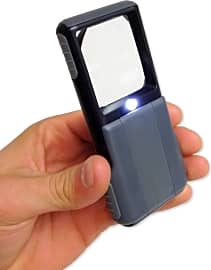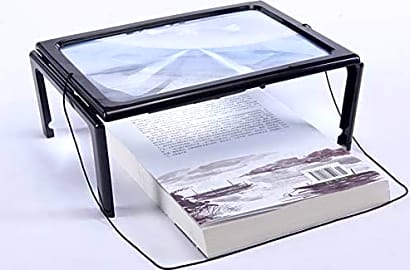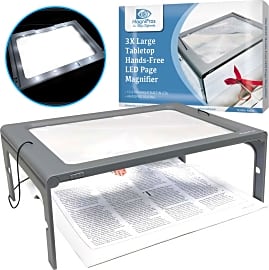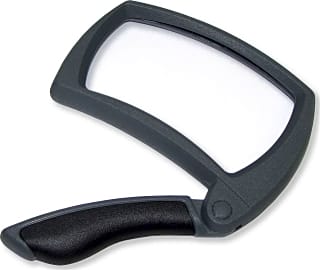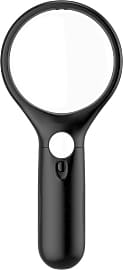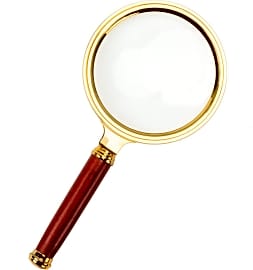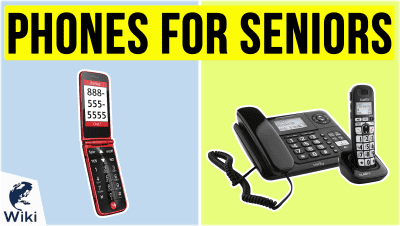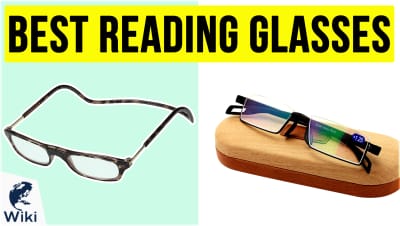The 10 Best Reading Magnifiers

This wiki has been updated 42 times since it was first published in October of 2015. Due to so called "middle-aged" presbyopia, most people will need some help reading small print at some point in their lives. If you would rather not wear glasses, these magnifiers can come in handy for brief periods. They can be quite useful for hobbyists, like coin and stamp collectors, and can help to reduce eyestrain when enjoying a newspaper or magazine article printed in a small font. When users buy our independently chosen editorial picks, we may earn commissions to help fund the Wiki.
Editor's Notes
July 23, 2020:
In selecting our reading magnifiers, we kept in mind that it's important for users to be comfortable when sitting down to look over small text, especially when enjoying extended reading sessions of novels and longer-form content. So we prioritized models that shouldn't leave you cramping up or craning to see. We also wanted to include a range of magnification options, and selections that have several different lenses each, for those who need to switch between tasks that involve various sizes of texts.
The Easyinsmile Large Rectangular and the MagniPros Full Page stood out due to their user-friendly designs. Thanks to their foldable legs, they allow for hands-free operation, as individuals can simply prop the items' large lenses right over their reading material. Though the Carson MJ-50 does require users to hold the item while reading, it has a comfortable, ergonomic grip that should minimize hand fatigue.
Those who may need to look at a variety of font sizes every day might appreciate the RockDaMic Premium Handheld, which has both 3X and 45X magnification lenses, and the iMagniphy 3-Lens Set, which has three lens attachments offering varying degrees of magnification that can be switched in and out as needed.
When you can't always sit by your desk lamp, models with built-in lights can be very useful, like the MagniPros 3X, which has dimmable bulbs, and the Fancii FC Optics Lighted, which has a row of LEDs across its frame.
We wanted to include a digital reader, too, as these offer so many ways for you to customize your viewing experience. Unfortunately, we had to remove the ViSee LVM-480 as its functions prove very difficult to operate for those with any hand-eye coordination issues or motor function problems. In its place came the Eyoyo 5.0, which has several brightness and color modes, and is compatible with TransFlash cards.
May 21, 2019:
Finding the right reading magnifier is often determined by your personal requirements. For example, someone that just needs to read nutrition labels at the supermarket will want a very different type of model than a person who enjoys reading books for long periods of time. With that in mind, we made sure to include a nice variety of options to suit every user and need. If you are the aforementioned person who simply wants to make it easier to read labels while on the go, we recommend the Carson MiniBrite, as it will easily fit into a pocket. If you like to read books or the newspaper for long periods of time in a single sitting, a hands-free option like the Carson DeskBrite 200 and MagniPros Full Page is a good choice. The MagniPros Full Page even has a lanyard, so you can rest it around your neck when relaxing on the couch. Digital options like the Eyoyo 5.0 and ViSee LVM-480 deserve special mention for their versatility. They allow you to adjust the magnification level, making them great for multi-user households, can attach to external displays, and are lit for nighttime use. While maybe not ideal for an hour or two of recreational reading, basic handheld models such as the iMagniphy LED Set, RockDaMic Glass, Basport Loupe, MagniPros 3X, and Carson MJ-50 make good multi-use options. They are great for a quick glance over the days headlines, reading nutrition labels at home, or craft work.
Special Honors
Sharper Image Full-Page Floor Magnifying Lamp With an 8-by-10-inch viewing area, the Sharper Image Full-Page Floor Magnifying Lamp can cover an entire book page in most cases. It has 12 LEDs, and its frame is attached to a tall, flexible gooseneck, making it easy to position at the most comfortable angle for your needs. The acrylic lens resists cracking, and it's available in a black or bronze finish. sharperimage.com
ULine Rectangular Magnifier In addition to its more moderate lens in the frame, the ULine Rectangular Magnifier also has a small viewing area in the handle that enlarges content by 1,150 percent. It can be hand held or used hands-free, thanks to its comfortable contoured grip and foldaway legs. For added convenience, there is a small hole through which you can thread a lanyard. uline.com
Why Reading Magnifiers Can Be Better Than Glasses
Some reading magnifiers reproduce the text on a small LCD screen in a color scheme that's easier to read.
Reading magnifiers are an incredibly useful tool for people suffering from conditions like macular degeneration, cataracts, or glaucoma. Some might wonder why a person would use a reading magnifier when, in essence, reading glasses simply are two small magnifiers that can be worn on one's head. But reading magnifiers can do things that glasses cannot. For example, not every text is created in the same size, and advanced reading magnifiers allow you to adjust the magnification to match everything you read. Some can magnify a text up to 25 times its original size.
People who suffer from glaucoma often also struggle with color vision deficiency and the dull black font set against the gray paper of newspapers can be a difficult color scheme for those with vision impairment to detect. Some reading magnifiers reproduce the text on a small LCD screen in a color scheme that's easier to read. Many models act as small reading lamps, too, with a bright LED light shining out of the magnifying glass, illuminating the text.
These types generally have a base so they can stand on a surface, and they usually have a flexible neck so the reader can bring them closer or further from their text. These lamp-style magnifiers are ideal for hobbyists who need their hands to work on detailed tasks, like assembling model ships.
As for the concern that reading magnifiers are bulkier than reading glasses, most are designed to fit in the palm of one's hand or pocket. Of course, you have the option of getting one with an extra wide screen, so that you can magnify nearly an entire page of text at once, and not need to move your hand much while reading.
Important Additional Uses For Reading Magnifiers
Reading magnifiers aren't just important for helping seeing impaired individuals read books and periodicals; they can help them navigate the world in many other ways. People who use special phones for the hearing and seeing impaired might need extra help seeing the name of the caller on their receiver, or reading the callback number for someone with whom they need to get in touch.
So a reading magnifier can help someone with vision troubles navigate their way around a new city.
It can also be very important for them to read their prescription medication instructions when they do not have a nurse or aid to help them do so. Prescription medications typically have various font sizes between the general directions, special warnings and side effects, so the ability to adjust the magnification on these is critical.
The chances of vision loss increase after the age of 65, and this generation's seniors are not as well-versed with technology as the youth is, so many elderly individuals still use paper maps. Maps, like prescriptions, also have varying font sizes between the names of counties, towns, bodies of water and longitude and latitude readings. So a reading magnifier can help someone with vision troubles navigate their way around a new city.
Digital television guides are also something that mostly the younger generation knows how to work, leaving most seniors to read physical television guides. These typically have a tiny font for the channel names, an even smaller font for the program names, and a minuscule one for the show's description. So, again, the option to adjust the magnification is very useful here.
The History Of The Magnifying Glass
Ancient Egyptians, Greeks, and Romans were at the forefront of many inventions, and the magnifying glass is no exception. Thousands of years ago, Egyptians would look through pieces of crystal and other shiny stones in order to magnify items.
This book would go on to be an important part of the development of seeing eyeglasses, which were developed in Italy in the 13th century.
From 30 to 60 CE, the Roman Emperor Nero would look through gemstones to get a better look at theater productions. He was also one of the first people to wear gemstone sunglasses. The famous Roman naturalist Pliny the Elder would also use magnifying glasses to burn the flesh off of wounds between 23 CE and 79 CE.
There are also some jokes in the Ancient Greek play "The Clouds," (424 BCE) that mention magnifying glasses being used to start fires. The joke refers to magnifying glasses being sold in pharmacies, so they may have been a common household product at the time. It wasn't until the 1200s that the first magnifying glass was created for scientific use. Historians give credit to an English philosopher named Roger Bacon for this invention.
Around the time Bacon invented his version of the magnifying glass, the Arab mathematician, and scientist, Ibn al-Haytham spoke of a convex lens with which he magnified images in his book "Book of Optics." This book would go on to be an important part of the development of seeing eyeglasses, which were developed in Italy in the 13th century.


